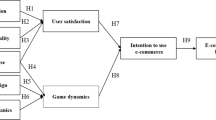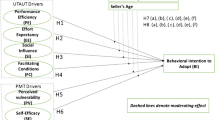Abstract
The study discussed in this paper uses case studies of six small voluntary organizations to determine the primary factors that influence electronic commerce (EC) adoption. The findings indicate that perceived benefits, including efficiency, information sharing, marketing and increased donations have a strong influence on EC adoption. The results also indicate that organizational readiness, including ability to attract volunteers and/or in-kind donations, ability to raise funds, and strategic readiness had a positive influence on EC adoption. Consistent with prior research on EC adoption in the commercial sector, strong support was found for the influence of perceived pressure, including pressure from both internal and external stakeholders. The study also concluded that perceived social risks associated with the loss of human contact and the perception of dollars being diverted from client programs to finance the EC investment had a strong influence on EC adoption. Implications for EC adoption and future research on EC adoption in the voluntary sector are discussed.

Similar content being viewed by others
References
Bonoma TV (1985) Case research in marketing: opportunities, problems, and a process. Journal of Marketing Research 22(2), 199–208.
Boyle A, Macleod M, Slevin A, Sobecka N and Burton PF (1993) The use of information technology in the voluntary sector. International Journal of Information Management 13(2), 94–112.
Burt E and Taylor JA (2000) Information and communication technologies: reshaping voluntary organizations? Nonprofit Management & Leadership 11(2), 131–143.
Canadian Center For Philanthropy (2002) http://www.ccp.ca/information/links.html. Accessed on October 25, 2002.
Chan YE and Huff SL (1993) Strategic information systems alignment. Business Quarterly 58(1), 51–55.
Charity Commission for England and Wales (2002) Giving confidence in charities: annual report 2001–2002. London, England.
Daniel E, Wilson H and Myers A (2002) Adoption of e-commerce by SMEs in the UK: towards a stage model. International Small Business Journal 20(3), 253–270.
Drucker P (1994) The age of social transformation. Atlantic Monthly 274(5), 53–80.
Eisenhardt KM (1989) Building theories from case study research. Academy of Management Review 14(4), 532–550.
Glaser BG and Strauss AL (1967) The Discovery of Grounded Theory: Strategies for Qualitative Research. Aldine Publication Co., Chicago.
Hall M and Banting KG (2002) The nonprofit sector in Canada: an introduction. Working Paper, School of Policy Studies, Queen's University.
Hall MH and Reed PB (1998) Shifting the burden: how much can government download to the non-profit sector. Canadian Public Administration 4(1), 1–20.
Heidegger M (1953) in David Farrell Krell (1993), Martin Heidegger Basic Writings: From Being and Time (1927) to The Task of Thinking (1964). HarperCollins Publishers: San Francisco, CA, pp. 307–342.
Iacovou CL, Benbasat I and Dexter AS (1995) Electronic data interchange and small organizations: adoption and impact of technology. MIS Quarterly 19(4), 465–485.
Igbaria M, Zinatelli N, Cragg P and Cavaye AL (1997) Personal computing acceptance factors in small firms: a structural equation model. MIS Quarterly 21(3), 279–305.
Madon S (1999) International NGOs: networking, information flows and learning. Journal of Strategic Information Systems 8(3), 251–261.
Markus LM (2000) Special issue on intensive research in information systems: using qualitative, interpretive, and case methods to study information technology. MIS Quarterly 24(1), 1–2.
Mcmullen K and Schellenberg G (2002) Mapping the Non-profit Sector. Canadian Policy Research Networks Series on Human Resources in the Non-profit Sector No. 1, December 2002.
Mehrtens J, Cragg PB and Mills AM (2001) A model of Internet adoption by SMEs. Information & Management 39(2), 165–176.
Morgan GG (1995) ITEM: a strategic approach to information systems in voluntary organizations. Journal of Strategic Information Systems 4(3), 225–237.
Nambisan S and Wang Y (1999) Roadblocks to web technology adoption? Communications of the ACM 42(1), 98–102.
National Council for Voluntary Organisations (2002) The size and scope of the UK voluntary sector: media briefing sheet. London, England.
Pargmegiani M and Sachdeva T (2000) Information and public policy concerning voluntary sector use of information technologies, the Internet and the World Wide Web: an international report. http://www.volnet.org/reports/english/exec.html.
Poon S (2000) Business environment and Internet commerce benefit – a small business perspective. European Journal of Information Systems 9(2), 72–81.
Premkumar G and Roberts M (1999) Adoption of new information technologies in rural small businesses. Omega 27(4), 467–484.
Putnam R (1995) Bowling alone: America's declining social capital. Journal of Democracy 6(1), 65–78.
Ryan WP (1999) The new landscape for nonprofits. Harvard Business Review 77(1), 127–136.
Salamon LM and Anheier HK (1996) The Emerging Nonprofit Sector: An Overview. Manchester University Press, New York.
Saxton J and Game S (2001) Virtual Promise: Are Charities Making the Most of the Internet Revolution. Third Sector, London.
Straub DW, Hoffman DL, Weber BW and Steinfield C (2002) Measuring e-commerce in net-enabled organizations: an introduction to the special issue. Information Systems Research 13(2), 115–124.
Trauth EM and Jessup LM (2000) Understanding computer-mediated discussions: positivist and interpretive analyses of group support system use. MIS Quarterly 24(1), 43–79.
Volnet National Advisory Committee (1999) Building the technological capacity of the voluntary sector. http://www.volnet.org/english/buildingthetechnologyreport.htm.
Walczuch R, Van Braven G and Lundgren H (2000) Internet adoption barriers for small firms in The Netherlands. European Management Journal 18(5), 561–572.
Yin RK (1994) Case Study Research: Design and Methods. Sage, Thousand Oaks, CA.
Zwass V (1996) Electronic commerce: structures and issues. International Journal of Electronic Commerce 1(1), 3–23.
Author information
Authors and Affiliations
Corresponding author
Appendices
Appendix A: The six case organizations
Case A is an international medical charity founded in 1997 to support research and to improve the health and quality of life of sufferers. The charity's naming founder and spokesperson is a prominent Canadian. He has been successful in raising awareness amongst Canadians, and the organization is an extension of these awareness, education and research efforts. The charity has 25 employees and 10 volunteers. It is also involved in various partnerships and programs that financially support many activities in research, rehabilitation, education, and awareness. It is a founding member of a consortium of the world's most prominent private research funders. Revenues for the fiscal year 2001 were just over $6.4 M. It has just recently re-launched its website with an upgraded look and feel and with the objective of keeping it ‘easy to navigate and simple to read’.
Case B is one of Canada's best-known social foundations. International in scope, it was founded in 1991 by its charismatic, namesake leader. The foundation focuses on a few select issues and projects in order to educate the public and support research. It also advocates these issues to political decision-makers. The Foundation currently employs about 35 staff and has 36,000 members. Revenues for the fiscal year 2001 were $5.6 M. The foundation has had a website since 1996 and has gone through several re-developments. Currently, the website has several interactive components and an online donation capability.
Case C is in the arts and culture sector. It was founded in 1931 and is operated by a charitable society. It employs around 100 full- and part-time staff as well as over 300 volunteers. Its operating budget was over $5 million. It is a major tourist attraction and it also operates a souvenir store and a café on its premises. Volunteers participate in all of the daily operations with the regular staff. The first website was launched in 1998 and currently it has only very basic functionality without interactivity or online commerce capabilities. However, the organization has recently received a grant from a foundation supporting nonprofit website development in order to improve its website in the near future.
Case D is also in the arts and culture sector of the economy. It was founded in 1919 and employs over 100 staff, and 250 volunteers. The organization performs in a variety of venues to an annual audience of over 200,000 people. Its operating budget is $5 million. Arts education is also an essential part of its operations. Volunteers help in administrative tasks, the gift shop, and fundraising events. Web presence was first established in 1998. The current website was introduced in early 2001. The website has some interactivity as well as banner ads from sponsors. In addition, the organization has partnered with an e-commerce vendor to sell tickets to its performances.
Case E is a local organization that was founded in 1975 to support immigrant women and their young children in their adjustment to the Canadian community. It has 50 employees, 120 volunteers, and an operating budget of less than $500,000. The organization offers community-based programs including English-as-a-second-language (ESL) in order to provide immigrant women with training and practical work experience. It also offers consultation services to communities wanting to develop similar programs. Volunteers help with the training programs, children's daycare, and various office tasks. The website offers basic information about the organization and its programs. The organization launched its first website in 1998 as an initiative by its umbrella organization. It acquired its own domain name only in the fall of 2002.
Case F, also local, was founded in 1956. It provides information and services to the deaf and hard of hearing people, and educates the general public on issues surrounding hearing problems. It has 28 employees, five volunteers, and an operating budget of $2 million. The organization sells communication aid products and provides counselling and interpretation services; consequently, it does not depend heavily on volunteers. The website was introduced in 1998. Currently, it provides a simple product catalogue and an ordering capability through email. The organization has also partnered with an e-commerce vendor to facilitate online donations.
Appendix B: Semi-structured interview guidelines
Each interview adhered to the following sequence:
-
Provide background information on your organization, the decision to develop a website, and the evolution of that website.
-
Describe the role of the website in terms of your organization's business objectives.
-
Were any performance measures put into place before, during, or after development of the website? If so, what were/are they?
-
Describe, in detail, the evolution of your website in terms of its functionality, staff and customer reactions, stakeholder reactions, usage, and other comments.
-
What do you, and did you see as the risks in adopting the web?
-
Who funded development of the website? How were funds obtained?
-
Describe how you manage the website on a day-to-day basis. In the long run? Who is responsible for determining the website's content and functionality?
-
Is there anything else you'd like to tell us about your experience with the web so far?
-
Thank you!
Rights and permissions
About this article
Cite this article
MacKay, N., Parent, M. & Gemino, A. A model of electronic commerce adoption by small voluntary organizations. Eur J Inf Syst 13, 147–159 (2004). https://doi.org/10.1057/palgrave.ejis.3000491
Received:
Revised:
Accepted:
Published:
Issue Date:
DOI: https://doi.org/10.1057/palgrave.ejis.3000491




